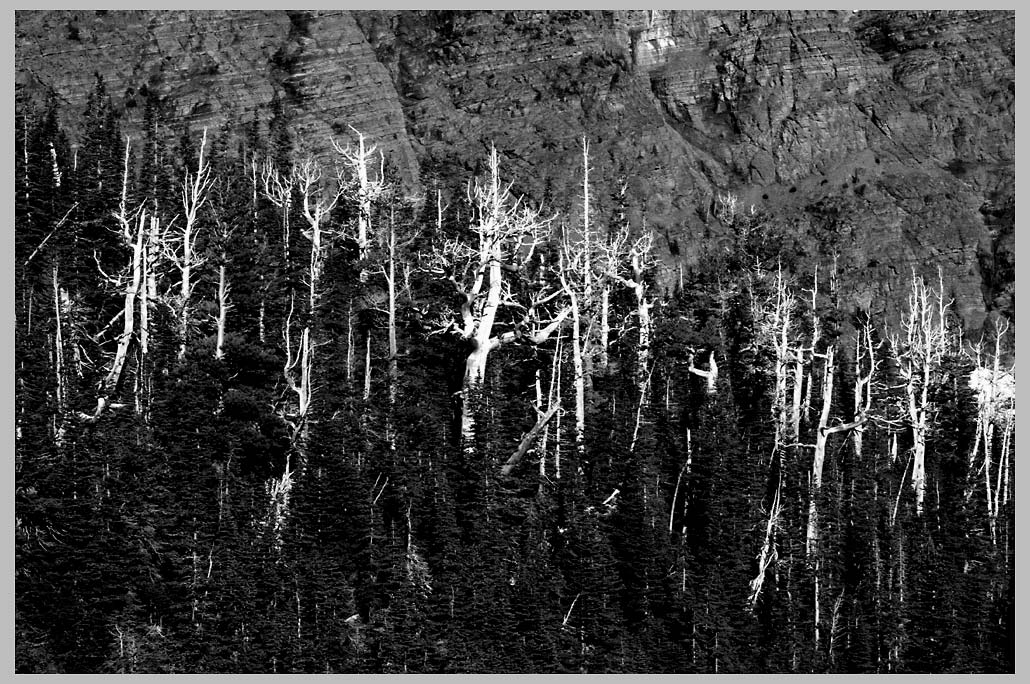

Whitebark Pine (Pinus albicaulis), "Skeleton Forest," GLACIER NATIONAL PARK
On the road in the American Northwest. [ click photo for next . . . ]


Whitebark Pine (Pinus albicaulis), "Skeleton Forest," GLACIER NATIONAL PARK
On the road in the American Northwest. [ click photo for next . . . ]
Whitebark Pines are in trouble around the mountains
of the Northwest. For me, they have become a sentinel species
because they are not only the grandest and, in my view, most
beautiful of pines to reach the upper limits of treeline—even
in death the sun-bleached white snags stand tall for centuries—
but also, like wounded watchful elders, these Nestors of the
high-country are sounding a dire message of warning.
This p/p DIALOGUE RESOURCE PAGE is a gathering together
of films that might help us listen to what the Whitebarks are saying.
It is also a kind of mirror of ourselves, as we reflect upon our own
response to what we see.
| see also my p/p DIALOGUE PAGE: WORLD WITHOUT NUCLEAR |
IN PRAISE OF NATURAL COMPLEXITY
From a single trunk, a thousand branches;
From a thousand rivulets and rills, a single stream.
Simple to complex; Complex to simple.
Complexity is richness, is diversity, is always good.
Complicatedness, or the unnecessarily convoluted or
difficult, is always bad.
Complicatedness, because of the contradictory, meaningless
way it wastes energy, is never a feature of natural systems.
FEAR AT NIGHT
When out camping, fear at night is not the same as fear by day. The
night opens a door to some all-but forgotten, distant, primal past. The
ear surrounded by darkness easily finds signs of the fierce, the brutal,
and the blood thirsty. The ear’s eye sees them all, acting out each and
every gory detail, each gruesome scenario. Fear at night. When the coyote’s
call brings to life an image of being surrounded by a starved pack
of ruthless timber wolves. Fear at night. When the sound of a mouse
causes us to leap upright with a start, ready to battle with Ursus horribilus?
Fear at night. When a mere rustle of leaves means an onslaught of
hungry cannibals, or headhunters, or raiding hordes in search of scalps
and trophy strings of severed fingers. And then when the light returns,
we always wonder and forget again. “What was that all about?
ROUGH ROAD AHEAD?
All passengers in a car running on a full tank
of fundamentalist religion, we’re tied up with
Freedom and Democracy in back. Money’s
in the driver’s seat, with Nation States,
spinning one against the other, for wheels.
“Hey,” somebody just yelled, “ Get out
at the next right!”
A NEW TENEBRISM *—towards an Art
as light as mountain air . . .
In Poetry and Photography, the title or frame
creates a background shadow of knowledge
of things implied, but left unsaid or unseen.
Out of this background emerge dramatically
contrasted centers of light and focus.
The balance of the resulting pattern as a whole
is its composition; the strength of emotion
thus awakened, the depth of its expression.
* from the Latin, tenebrae = darkness, or play of
the primary contrasts of white and black,
light and shadow
THE FLAT-TIRE MODEL OF REALITY
20 miles out, 20 miles back.
Got a flat; That’s a fact.
Hard as nails, Life’s like that.
Gotta act—now; That’s a fact!
Excuses, excuses, excuses—
Why can’t I live like that?
HABIT & TRUTH
Habit loves to be reformed;
Truth loves to be demonstrated.
ROAD OF CHANGE
Down the rough road of change, a mountain bike’s
wheel keeps its true by centering in the clear intentions
of its motionless hub.
Pine Lakes Camp,
Eagle Cap Wilderness,
Oregon, X.29.2008
THE LITTLE CLAVIER please preview 150 of 631 pages
w/ my black & white photography [opens in new window]
All Photographs & texts by Cliff Crego © 2012 picture-poems.com
(created: III.5.2011)